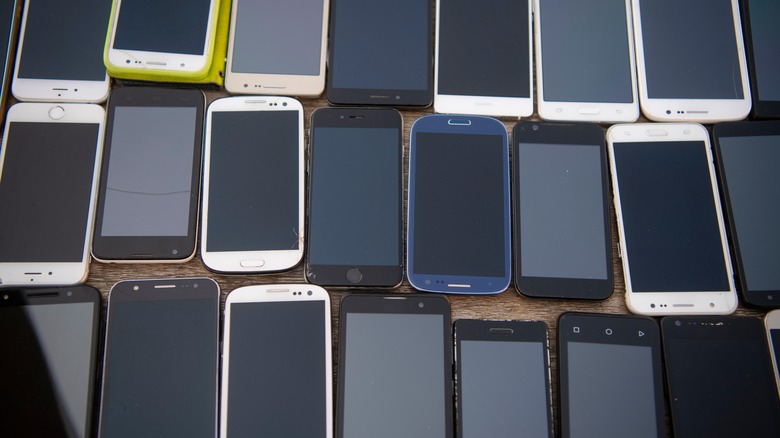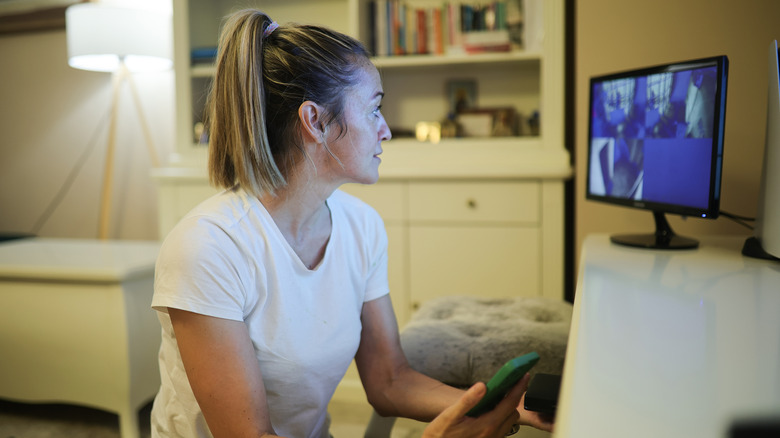Repurpose An Old Smartphone Into A Reliable Tool For Enhanced Home Security
We may receive a commission on purchases made from links.
If you have a box full of old smartphones sitting in a closet somewhere, there's a good chance you have everything you need to create a security camera network that can help prevent someone from breaking in and stealing your box of old smartphones. This magic happens at the intersection of two facts: even old smartphones have cameras in them, and they usually work with just Wi-Fi, not requiring any kind of cell network connection. These ad hoc security cameras might not create the best quality video you've ever seen, but that's okay. After all, "surveillance video" has long been synonymous with terrible video quality.
You might be thinking, "That phone was horrible, which is why I don't use it anymore. How is it going to work now, years later?" The answer is that, well, it might not. There are a lot of variables at play — such as the versions of Android or iOS supported by the hardware, security barriers on your phone or network, the quality of your device's Wi-Fi connection, and others. Generally speaking, the phone's operating system software was created with backward compatibility in mind, but if you have persistent problems, try repurposing another phone. Committing to an unworkable device for this project is like buying a subpar security camera, which is one of the mistakes you should avoid when buying a home security system. Regardless, once you settle on a working device, you've got a functioning security tool cheaper than the cheapest doorbell camera at Home Depot.
Platforms for smartphone security camera functionality
The key to repurposing your old smartphone into a security device is an iOS and Android app called AlfredCamera. It's a freemium app with a lot of useful features for creating your own security camera network. In camera mode, the app offers recording, zoom, low-light enhancement, motion detection, notifications, video sharing, and more. In its monitor mode, the app lets you choose among multiple cameras and includes features like two-way audio, control of camera features, and viewing/security options. AlfredCamera also works with standard security cameras, and the company actually sells cameras for this purpose.
While AlfredCamera is the most popular and highest-rated platform, it's not the only option. Competitors like TinyCam, AtHome, and Reolink offer similar functionality with a few differences: AtHome relies on a cloud-based system, for example, and Reolink is designed to work best with the company's own line of cameras. Options like Frigate NVR bring professional security tools to the table and can be integrated with home automation platforms like Home Assistant. You can also use Home Assistant and other smart home platforms as a basic viewer for IP and web cameras, and integrating your burgeoning security system into one of these platforms is a big step toward making your house a smart home.
That said, if you don't need all the object recognition and AI stuff that comes with smart home platforms, OBS Studio and the freemium DroidCam app gives users tons of multi-camera streaming options. Designed for professional video streamers, the open-source OBS Studio project is very stable.
Setting up your camera phone
There's not much stress involved with getting started. We'll walk through the AlfredCamera setup, but the process is similar for its competitors.
You'll need two old phones: one as a camera and one as a monitor. Install the app from the Google Play Store or Apple App Store on each device, then log in or create a new account. On the phone or tablet you want to use as a viewer, tap "Add a Camera." Scan the resulting QR code with the other device by tapping "Scan to Link to Viewer Device." Additional cameras connect the same way.
Your viewer can be anywhere, but installing your camera can be more challenging. It should run off main power rather than battery, so you'll need access to an outlet, a power brick, and a sufficiently long charging cable. One way of mounting the camera to a wall is to use an inexpensive smartphone tripod mount (Amazon has one for less than $10). It's important to use a tripod mount because they come with integrated, standard ¼-20 threading for attaching the mount; you don't want to wrestle with suction cups or air-vent clips. Acquire a hanger bolt with ¼-20 threading on the bolt side and a wall anchor that fits the wood screw side. Install the anchor, screw in the hanger bolt, attach the phone holder to the hanger bolt, and stick the phone in. Adjust the camera for your desired view, and you're all set!


